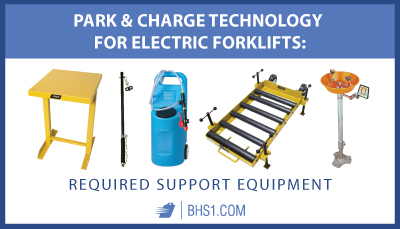We use cookies to make your experience better. To comply with the new e-Privacy directive, we need to ask for your consent to set the cookies. Learn more.
Park & Charge Technology for Electric Forklifts: Required Support Equipment
There is a lively debate between proponents of conventional forklift battery charging and those of fast charging, or park & charge, technology. As with any competing technology, there's no easy answer about which system is superior. Different fleets have different needs, and that means either type of technology could be a better fit. That said, here are some of the advantages that some users derive from park & charge systems, along with some of the extra gear operators will need to keep these systems more efficient and durable.
One of the most attractive benefits of park & charge technology is its simplicity.
Fast charging systems rely on charging forklift batteries during periods of downtime, such as lunch hours or other existing breaks. By continually recharging a battery, fleets do not have to change out batteries to charge them.
Reducing forklift battery change-outs comes with a host of benefits, like buying and maintaining fewer batteries per forklift and eliminating some battery handling equipment altogether. In order to get the most life and performance out of forklift batteries and fast chargers, though — to say nothing of compliance with safety regulations — park & charge users need to invest in the following pieces of equipment:
1. Charger Stands with Structural Barriers
Park & charge equipment manufacturers recommend placing chargers in the areas where employees are likely to take breaks. This less-traditional facility layout requires managers to take extra precautions to protect chargers. After all, when a battery charger sits in the middle of the floor, it's much more vulnerable to forklift strikes.

Charger Stands, Dual Charger Stands, and Charger Wall Brackets all bestow unique benefits while helping operations comply with OSHA standard 1910.178(g)(2), which mandates that businesses must protect charging apparatuses from lift trucks. In some instances, operations may want to use Structural Barriers to further reduce the possibility of collisions with chargers.
2. Cable Management Equipment
Because park & charge fleets have more chargers scattered around a warehouse, good cable management is essential. Using Cable Retractors or Magnetic Cable Mounts keeps a charger area tidy by keeping cables untangled. This speeds up the charging process, increases cable longevity, and makes for a safer workspace.
3. Water Carts and Water Guns
Fast charge technology greatly reduces the number of change-outs that occur for a forklift fleet, but that doesn't mean that you don't have to perform basic maintenance from time to time. One of the most basic maintenance tasks that forklift batteries require is adding water to the cells after charging.
Water Carts and Water Guns make this task easier, safer, and more ergonomic. Instead of leaning over a battery with a jug of water and eyeballing how much it needs, maintenance workers can use specialized equipment to fill cells precisely. Water Guns from BHS have diffusers to regulate the flow of water and automatic shut offs that prevent over filling.
4. Battery Service Stands
Other maintenance tasks, like washing forklift batteries, require removing the battery altogether. For these tasks, it's important to have a reliable Battery Stand that can safely support the battery while giving workers 360-degree access.
5. Battery Spill Kits and Eye & Safety Stations
Maintaining appropriate safety equipment is necessary to comply with OSHA regulations that protect workers. Batteries contain sulfuric acid that can seriously harm staff and damage equipment.
Battery Spill Kits contain protective gear for workers and neutralizing agents for the spill. Eye and Safety Stations allow workers to quickly flush eyes and wash skin in the worst case scenario of exposure to battery acid. When configuring chargers and safety stations, remember that OSHA standard 1926.441(a)(6) requires that eye-washing stations be located within 25 feet of all charging areas.
Every manager must decide which technology makes the most sense with their needs and current facilities.
Some operations may not have the electrical infrastructure to power fast charge technology. Realities like these may make investing in the technology a non-starter. Of course, some managers may love the simplicity of park & charge and decide to put forward the larger initial investment necessary for fast charging batteries.
Every operation has unique needs that may make either method of charging more attractive. The important thing to remember is that conventional battery handling equipment is essential to maintaining lift truck batteries whichever charging technology an operation chooses.
References:
"Batteries and battery charging — 1926.441." OSHA. Occupational Safety and Health Administration, United States Department of Labor, n.d. Web. 6 Nov. 2017.
McLeod, Scott. “Forklift Fast Charging: the Positives and Negatives.” MHLNews. Material Handling & Logistics, 1 Nov. 2010. Web. 6 Apr. 2017.
“Powered industrial trucks – 1910.178.” OSHA. Occupational Safety and Health Administration, United States Department of Labor, n.d. Web. 6 Nov. 2017.
